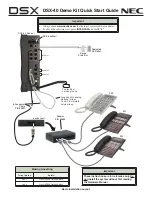
Managing Dial Plan Pretranslators
297
Creating a
Pretranslator for
VTL Calls
Calls from one system to another system over a VTL connection include
caller ID information that includes the IP address of the caller’s system and
the caller’s extension. The “*” character separates each field of numbers
in this caller ID string. For example, if extension 1002 on System A calls
someone on system B over a VTL connection, the display panel on the
System B telephone displays
10*234*208*2*1002
, which indicates an
incoming call from extension 1002 on the system with the IP address
10.234.208.2.
If the System B dial plan has a pretranslator that removes the IP address
when the call arrives at System B, (see
Figure 14
on
page 298
), the
display panel on the System B telephone displays the calling extension
and no IP address or “*” characters. This solution works well when the
extensions on System A and System B do not overlap, for example,
System A user extensions are 1000-1999 and System B extensions are
2000-2999.
Call Detail Reports (CDR) Records
CDR records incorporate caller ID information to identify a caller. VTLs
transmit a maximum of 30 characters for the caller ID. Because the caller
ID for incoming VTL calls also includes the IP address before the extension
number, the 31st and subsequent characters are dropped from the caller
ID. Consequently, the CDR records might contain abbreviated caller ID
information. If you enable CDR and VTL, add a pretranslator to avoid
inaccurate data.
Site Codes
If the dial plan on System B uses a site code, such as 69, for VTL calls to
System A, you can create a pretranslator that prepends the site code after
it removes the IP address. (See
Figure 15
on
page 299
.) This pretranslator
would provide caller ID information that the System B extension can use
to return a call to the System A extension. For example, a call from
System A (10.234.208.2) extension 1002 would appear on a System B
telephone’s display panel as
691002
instead of
10*126*14*200*1002
. The
pretranslator removes the IP address and prepends the calling extension
with the System A site code, 69.
You might choose to not implement this pretranslator if calls from System
A can hop off at System B onto a PRI line because the site code would be
included as caller ID information about the PRI line, and that caller ID
Содержание 3C10402B
Страница 18: ...18 ...
Страница 22: ...22 ABOUT THIS GUIDE ...
Страница 26: ...26 CHAPTER 1 INTRODUCTION ...
Страница 74: ...74 CHAPTER 3 FEATURE SETTINGS ...
Страница 130: ...130 CHAPTER 5 TELEPHONE CONFIGURATION ...
Страница 156: ...156 CHAPTER 7 CALL DISTRIBUTION GROUPS ...
Страница 194: ...194 CHAPTER 8 PSTN GATEWAY CONFIGURATION ...
Страница 256: ...256 CHAPTER 10 SIP MODE OPERATIONS ...
Страница 328: ...328 CHAPTER 11 DIAL PLAN ...
Страница 360: ...360 CHAPTER 13 DOWNLOADS ...
Страница 370: ...370 CHAPTER 14 LICENSING AND UPGRADES ...
Страница 406: ...406 CHAPTER 16 NETWORK MANAGEMENT ...
Страница 412: ...412 CHAPTER 17 COUNTRY SETTINGS ...
Страница 450: ...450 APPENDIX A INTEGRATING THIRD PARTY MESSAGING ...
Страница 456: ...456 APPENDIX B ISDN COMPLETION CAUSE CODES ...
Страница 510: ...510 APPENDIX F OUTBOUND CALLER ID AND 911 SERVICE ...
Страница 546: ...546 APPENDIX G NBX ENTERPRISE MIB ...
Страница 566: ...566 GLOSSARY ...
Страница 578: ...578 INDEX ...
Страница 582: ......
















































